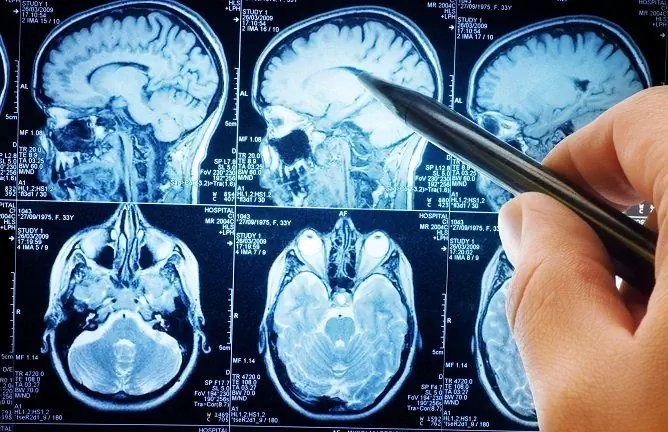- Author Rachel Wainwright [email protected].
- Public 2023-12-15 07:39.
- Last modified 2025-11-02 20:14.
Seborrheic dermatitis
The content of the article:
- Seborrheic dermatitis causes and risk factors
- Forms of the disease
-
Symptoms of seborrheic dermatitis
- Oily seborrheic dermatitis
- Dry seborrheic dermatitis
- Features of the course of the disease in children
- Diagnostics
- Treatment of seborrheic dermatitis
- Possible complications and consequences
- Forecast
- Prevention
- Video
Seborrheic dermatitis is a chronic inflammatory skin disease that occurs as a result of dysfunction of the sebaceous glands.

Dry seborrheic dermatitis is common in infants
Sebaceous glands are multicellular alveolar external secretion glands that are almost always associated with hair. Sebaceous glands are localized in the border sections of the papillary and reticular layers of the dermis and are located more superficially than sweat. Most of the sebaceous glands are found on the face, neck, back, scalp. There are no sebaceous glands on the skin of the palms and soles of the feet. The greatest development of the sebaceous glands is observed during puberty under the influence of progesterone in women and testosterone in men. Sebum secreted by the sebaceous glands softens the skin, enhances its antimicrobial and barrier functions, and is a fatty lubricant for hair.
With seborrheic dermatitis, the amount and quality of sebum secreted changes, which, depending on the form of the disease, can be accompanied by skin inflammation, oily sheen in the affected areas, thickening of the stratum corneum, peeling of the skin, as well as thinning, fragility and (in some cases) hair loss. The disease contributes to the appearance of acne, as well as pustular rashes on the skin (pyoderma).
Seborrheic dermatitis occurs in all age groups, and is more often diagnosed in people aged 20-50 years.
Seborrheic dermatitis causes and risk factors
The immediate cause of seborrheic dermatitis is the yeast-like lipophilic fungus Pityrosporum ovale (also known as Malassezia furfur). This fungus is part of the normal microflora of the skin in about 90% of the population. In the normal state of the immune system, the number of microorganisms of the resident microflora of the skin is regulated, fungi are on the skin in a spore state. However, in a number of pathological conditions, their activation is noted. Fungi actively reproduce near the sebaceous glands, since the fatty acids contained in the secretion secreted by the glands are necessary for their growth and reproduction. The increased vital activity of fungi causes signs of seborrheic dermatitis. In healthy people, the fungal flora of the scalp makes up 30-50% of all microorganisms that live on the scalp. With seborrheic dermatitis, the amount of fungi reaches 90%, while the leading role in the development of the pathological process belongs to Pityrosporum ovale.

The Pityrosporum ovale fungus begins to multiply actively when immunity is weakened
Risk factors for developing seborrheic dermatitis include:
- hereditary predisposition;
- diabetes mellitus (with it, the amount of fungal microflora on the skin can double);
- hormonal disorders against the background of diseases (in particular, a violation of the normal ratio between the level of estrogens and androgens);
- natural change in hormonal levels (puberty, pregnancy, premenopausal period);
- immunodeficiency;
- diseases of the gastrointestinal tract;
- chronic infectious processes;
- metabolic disorders;
- lack of vitamins and minerals;
- neurological diseases;
- nervous disorders, distress;
- severe overwork;
- excessive physical activity;
- climate change;
- irrational treatment of dandruff.
The main reason for the development of seborrheic dermatitis in infants is an increased concentration of hormones in mother's milk.
Forms of the disease
Depending on the characteristics of the clinical picture, the following forms of seborrheic dermatitis are distinguished:
- oily (observed mainly during puberty);
- dry (often diagnosed in infants, as well as in children before puberty);
- mixed (more often observed in men).
The fatty form of seborrheic dermatitis, in turn, is divided into thick and liquid. The thick form is more often observed in males, and the liquid in women.
Symptoms of seborrheic dermatitis
The clinical picture of seborrheic dermatitis depends on the form of the disease, as well as on the localization of the pathological process. Seborrheic dermatitis is prone to a chronic course with exacerbations in the autumn-spring period. Exacerbations may be accompanied by the development of erythroderma.
Seborrheic dermatitis on the head begins with the appearance of small white scales on the scalp, which is accompanied by itching. In the absence of adequate treatment, as well as irregular hygienic care, the pathological process progresses, peeling becomes more pronounced. In the case of a prolonged course of the disease, foci of inflammation appear on the skin in the form of red spots, plaques covered with scales and / or crusts. The increased flaking of the skin, characteristic of seborrheic dermatitis of the scalp, causes dandruff, and hair thinning can be observed. When scratching the affected skin surface, it is possible to attach a bacterial infection with the subsequent development of purulent skin lesions (pyoderma).
In addition to the scalp, seborrheic dermatitis often affects the skin of the face and upper body due to the fact that these areas are rich in sebaceous glands.
The lesions in seborrheic dermatitis on smooth skin are red or pink in color and are covered with scales of exfoliated epidermis. The spots gradually increase in size and merge with other spots. With seborrheic dermatitis on the face, rashes are often located in the area of the nasolabial folds and eyebrows, and are also combined with seborrhea of the scalp.
Oily seborrheic dermatitis
With oily seborrhea, the scalp is covered with large, light yellow scales. If you remove the scales, pink, slightly inflamed skin is found under them. The scales can flake off spontaneously, either singly or in layers. The pathological process is usually not accompanied by itching. With the progression of the disease, the hair becomes thinner, exfoliates at the ends, becomes brittle, and can also fall out. The normal amount of hair is usually restored only in the remission stage. Due to dehydration of the scalp after shampooing, patients may experience a tightening sensation, despite the increased oiliness of the scalp with seborrheic dermatitis. Often the lesions are located behind the ears, causing cracks that are crusty and prone to bleeding.

Oily seborrheic dermatitis
With a thick form of oily seborrheic dermatitis, there is a decrease in the elasticity of the skin, its compaction, the mouths of the sebaceous glands expand, the skin acquires a brownish-gray tint. Because of the blockage of the excretory ducts, comedones appear on the skin. Hair becomes coarse, coarse.
The liquid form of oily seborrheic dermatitis is characterized by enlarged pores, due to which the skin visually resembles an orange peel. The production of sebum is enhanced, due to a change in its qualitative composition, the bactericidal properties of sebum decrease, which contributes to the addition of a bacterial infection. The hair on the head has a greasy sheen, covered with yellow scales, the hair strands stick together.
Dry seborrheic dermatitis
With the dry form of seborrheic dermatitis, the secretion of sebum decreases. The hairy part of the head is covered with scales. Hair becomes thinner, becomes dry and brittle, and may fall out. The skin has pink or red patches covered with scales. The pathological process is accompanied by itching, which intensifies when exposed to cold water on the affected skin.
The mixed form of seborrheic dermatitis is characterized by the presence of signs of both dry and oily forms of the disease in different areas of the skin.

Dry seborrheic dermatitis
If the diet is violated, the symptoms of seborrheic dermatitis may be more pronounced (especially when drinking alcoholic beverages, large amounts of sugar, and some spices).
Features of the course of the disease in children
Infantile seborrheic dermatitis often occurs in infants, and usually resolves by stopping breastfeeding. The disease can be manifested by the appearance of greasy crusts of brown, silvery-white or gray-green color, the skin under which may be hyperemic or not changed. In the future, the pathological process spreads further - to the forehead, temples, back of the head, bridge of the nose, eyebrows, cheeks, skin behind the ears, etc. The affected areas of the skin are hyperemic and scaly, the affected skin is dry. Lesions can also appear on the limbs and trunk, in natural folds, while they are clearly separated from healthy skin. Hair in the affected areas becomes thinner and falls out. Sometimes there is inflammation of the eyelids. The pathological process is accompanied by slight itching.
Diagnostics
To make a diagnosis, as a rule, it is sufficient to collect an anamnesis and an objective examination of the patient. Culture inoculation on Pityrosporum ovale is not carried out, since this fungus is usually part of the normal microflora of the skin of healthy people. To clarify the diagnosis, dermatoscopy and dermatotricoscopy may be required.
In some cases, differential diagnosis is required with acne, psoriasis, rosacea, and other fungal skin diseases. In children, differentiation of seborrheic dermatitis with atopic is carried out.
Treatment of seborrheic dermatitis
Treatment of seborrheic dermatitis primarily focuses on proper care of the skin and scalp. It is necessary to eliminate the unfavorable factors that contribute to the development of the disease.
Shown are antimycotic drugs for topical use. If antifungal therapy is ineffective, hormone-containing drugs are prescribed in the form of an ointment. Topical anti-inflammatories may be prescribed. When a secondary infection is attached, antibacterial drugs are used.

With seborrheic dermatitis, it is important to organize proper skin care
When treating the oily form of seborrheic dermatitis, antiandrogenic drugs are prescribed, which help to reduce the production of sebum.
For the local treatment of the oily form of seborrheic dermatitis, alcohol solutions are used, which include boric, salicylic acid, sulfur, medicinal shampoos and lotions, as well as rubbing preparations with tar and zinc into the scalp.
With the dry form of seborrheic dermatitis, vitamin-containing preparations in the form of a cream and / or lotion, sulfur-salicylic ointment, preparations containing azelaic acid are used.
When treating a mixed form of seborrheic dermatitis, drugs are combined for oily and dry forms of the disease.
Of the methods of physiotherapeutic treatment for seborrheic dermatitis, phototherapy (it helps to fight against pathogenic microflora), local darsonvalization (therapeutic effect with high-voltage, high-frequency and low-force pulsed current), cryomassage of the scalp (liquid nitrogen), magnetotherapy have proven themselves well. Local physiotherapeutic methods in the treatment of seborrheic dermatitis allow to regulate the production of sebum, improve microcirculation in blood vessels, and help eliminate foci of inflammation.
To correct hormonal disorders (with an increased testosterone content and a decrease in estrogen levels), systemic physiotherapy methods can be used that contribute to the correction of hormonal disorders, such as ozone therapy and general darsonvalization (inductotherapy), etc.
Such a physiotherapeutic method as percutaneous electroneurostimulation can be applied both locally and systemically. The method is based on the impact on reflex zones with weak electrical impulses. With systemic exposure, the method contributes to the correction of hormonal levels, and in the case of local application to the affected areas of the scalp, percutaneous electroneurostimulation improves blood circulation, normalizes the transport of nutrients to the hair follicles, and has an anti-inflammatory effect.
Patients are shown vitamin complexes (especially vitamins A, C, E, as well as B vitamins), trace elements (iron, phosphorus, sulfur).
Patients with seborrheic dermatitis are recommended a diet with the exclusion of fatty, fried, salty and sweet foods from the diet.
Treatment of seborrheic dermatitis in women during pregnancy is symptomatic. Prescribed medicinal shampoos and topical preparations in the form of an ointment, which have no contraindications during pregnancy.
Possible complications and consequences
Seborrheic dermatitis can be complicated by the following conditions:
- hair loss (alopecia);
- the appearance of severe conglobata (confluent) acne, which is difficult to treat;
- the appearance of boils;
- inflammation of the hair follicles (folliculitis);
- diffuse dry streptoderma;
- dandruff.
With the development of seborrheic dermatitis during pregnancy, the risk of developing the disease in a child after birth increases.
Forecast
With the right treatment, the prognosis is favorable.
Prevention
In order to prevent the development of seborrheic dermatitis, it is recommended to adhere to a number of measures aimed at strengthening the body's defenses:
- timely treatment of diseases of internal organs;
- compliance with the rules of personal hygiene;
- hardening;
- moderate sunbathing;
- moderate physical activity;
- getting enough night sleep;
- balanced diet.
Video
YouTube video related to the article:

Anna Aksenova Medical journalist About the author
Education: 2004-2007 "First Kiev Medical College" specialty "Laboratory Diagnostics".
The information is generalized and provided for informational purposes only. At the first sign of illness, see your doctor. Self-medication is hazardous to health!






